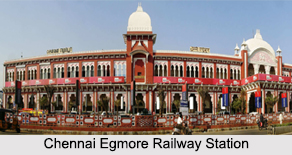 Chennai Egmore is a railway station in the South Indian metropolis, Chennai. It is one of the two direct railway terminals in the city. It is one of the prominent landmarks of the city of Chennai. The station serves not only to the south but also to the north (Hyderabad) and east (Howrah). Also, the Chennai - Mumbai Dadar Central Express (west) originates from the Egmore station.
Chennai Egmore is a railway station in the South Indian metropolis, Chennai. It is one of the two direct railway terminals in the city. It is one of the prominent landmarks of the city of Chennai. The station serves not only to the south but also to the north (Hyderabad) and east (Howrah). Also, the Chennai - Mumbai Dadar Central Express (west) originates from the Egmore station.
Location of Chennai Egmore Railway Station
Chennai Egmore is situated 3 kilometres away from the Chennai Central station which caters to the southern traffic of India connecting Chennai, Kerala and southern and central India.
History of Chennai Egmore Railway Station
According to the history, the station was actually a fort, called the "Egmore Redoubt". The construction work began in September 1905 and was completed in 1908. It was constructed by contractor T. Samynada Pillai of Bengaluru at a cost of 17 lakh. The station was authoritatively opened on 11th June 1908. The station became a foremost metre-gauge terminal after the development of the Southern Railway in 1951 and served as the doorway to the southern Tamil Nadu. In June 2006, the second entrance was opened.
Architecture of Chennai Egmore Railway Station
The architecture of the station is a unique mixture of three styles of architecture namely the Moghul, Gothic and European Renaissance style. The central entrance to the station is located on Gandhi-Irwin Road and brings the entrance on Poonamallee High Road. The station lies between two flyovers separated by a distance of about 925 metres. It has 11 platforms and the platforms 1, 2 and 3 are on the eastern surface. Platforms 4, 5, 6 and 7 lie under the dome and the platforms 10 and 11 are recently constructed ones.
The station has been divided into two zones for mechanised cleaning contracts-platforms 1 to 6 fall under zone I and platforms 7 to 11 fall under zone II. The station has a train care centre named "Egmore Railway Yard" where the trains arriving at the station are prepared for departure.
The Government Railway Police (GRP) and the Railway Protection Force (RPF) together launched a helpline in April 2012 which is known as "Kaakum karangal" in the terminus. This involved separating the terminus into three sectors and deploying 18 police staffs for safety measures.















